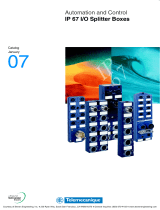
TeSys island – Digital Motor Management Solution
Disconnect Mains Power ................................................................... 142
Operations ...............................................................................................143
OMT Operations..................................................................................... 144
Operational Behavior ........................................................................144
System States............................................................................. 144
Connecting Your Tablet and Using the OMT ........................................ 145
Connecting to the OMT Using the Default IP Address..................... 148
User Preferences..............................................................................150
Control Panel..............................................................................152
Avatar View Panel.......................................................................154
Island View Panel........................................................................161
Diagnostics Panel .......................................................................167
Energy Monitoring Panel.............................................................. 169
Settings Panel ............................................................................172
Admin Options Panel...................................................................175
Powering On the island..........................................................................181
Powering Off the island ..........................................................................182
Module LEDs ...........................................................................................183
Updating the Firmware on the Bus Coupler........................................192
Device Replacement ..............................................................................193
Alarms and Events..................................................................................199
System Logs............................................................................................ 205
Troubleshooting ...................................................................................... 212
Appendix ..................................................................................................216
Avatar Composition ................................................................................217
Avatar Wiring Schematics and Accessory Diagrams.................................. 221
Bus Coupler with I/O Modules and Voltage Interface Modules .............. 222
Switch..............................................................................................222
Switch - SIL Stop, W. Cat 1/2 ............................................................. 223
Switch - SIL Stop, W. Cat 3/4 ............................................................. 224
Digital I/O ......................................................................................... 224
Analog I/O........................................................................................225
Power Interface without I/O (Measure)................................................ 225
Power Interface with I/O (Control) ...................................................... 226
Motor One Direction ..........................................................................226
Motor One Direction - SIL Stop, W. Cat 1/2 ......................................... 227
Motor One Direction - SIL Stop, W. Cat 3/4 ......................................... 228
Motor Two Directions ........................................................................229
Motor Two Directions - SIL Stop, W. Cat 1/2 ........................................ 230
Motor Two Directions - SIL Stop, W. Cat 3/4 ........................................ 231
Motor Y/D One Direction....................................................................232
Motor Y/D Two Directions ..................................................................233
Motor Two Speeds ...........................................................................234
Motor Two Speeds with Dahlandar Option .......................................... 236
Motor Two Speeds - SIL Stop, W. Cat 1/2 ........................................... 237
Motor Two Speeds - SIL Stop, W. Cat 3/4 ........................................... 239
Motor Two Speeds Two Directions ..................................................... 241
Motor Two Speeds Two Directions - SIL Stop, W. Cat 1/2 .................... 243
Motor Two Speeds Two Directions - SIL Stop, W. Cat 3/4 .................... 245
DOCA0270EN-00 5





















